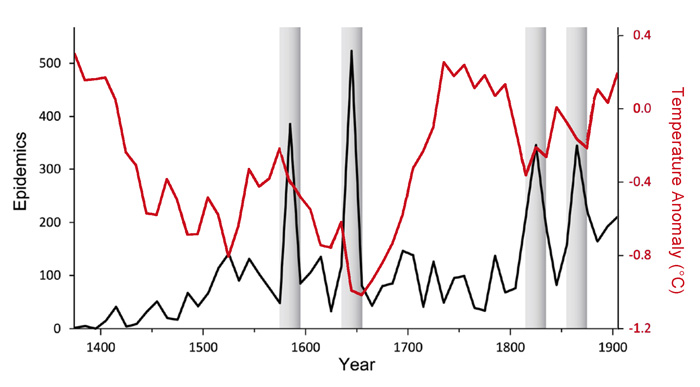| Follow @co2science |
Paper Reviewed
Lee, H.F., Fei, J., Chan, C.Y.S., Pei, Q., Jia, X. and Yue, R.P.H. 2017. Climate change and epidemics in Chinese history: A multi-scalar analysis. Social Science & Medicine 174: 53-63.
Many political and opinion leaders feel it is important to enact legislation to limit carbon dioxide emissions out of concern that global warming is detrimental to society. High among their list of anxieties is the fear that CO2-induced global warming will lead to social unrest and perhaps even war, primarily as a result of postulated reductions in agricultural output followed by population turmoil due to a lack of food. However, an emerging body of research suggests these concerns are not only unfounded, but almost always backwards-it is global cooling from which society stands the most to lose. Global warming, by contrast, tends to promote social stability, as evidenced by the findings of multiple peer-reviewed papers we have reviewed previously on our website (see the many reviews listed in our Subject Index under the heading War and Social Unrest).
The latest work to explore such a relationship comes from Lee et al. (2017). Publishing in the journal Social Science & Medicine, the six scientists analyzed the association between climate change and historic health-related epidemics recorded in China over the period 1370-1909 AD. For climate data, Lee et al. utilized the temperature reconstruction of Yang et al. (2002) and the precipitation reconstruction of Zhang et al. (2015). Epidemic data were aggregated from three independently derived datasets, (1) Collection of Meteorological Records in China over the Past Three Thousands Years (Zhang, 2004), (2) Historical Records of Infectious Diseases in China (Li, 2004), and (3) Epidemic Records in Historical China (Zhang, 2007). All data and the relationships among them were analyzed on three spatial scales (national, regional and provincial).
In all, there was a total of 5961 epidemic incidents across China during the study period. Statistical analyses revealed that precipitation was not significantly correlated with epidemic count. Temperature, on the other hand, was found to be "negatively correlated with epidemic incidents" (see figure below). Additionally, the scientists say they calculated that for every one standard deviation decrease in temperature at the country, regional or provincial level, increases of 162, 34 and 3.4 epidemic outbreaks were observed, respectively. Consequently, Lee et al. conclude that their analysis "supports the notion that climate change, be it the ultimate cause or direct trigger, acts as a driver of historical epidemics," but not in the way that climate alarmists contend. Without a doubt, global cooling -- as opposed to global warming -- is the climate that we should fear most when it comes to spawning population epidemics.

Figure 1. The relationship between temperature and epidemic incident count for all of China over the period 1370-1909 AD.
References
Li, W. 2004. Zhongguo Chuanranbing Shiliao [Historical Records of Infectious Diseases in China]. Chemical Industry Press, Beijing.
Yang, B., Braeuning, A., Johnson, K.R. and Shi, Y. 2002. General characteristics of temperature variation in China during the last two millennia. Geophysical Research Letters 29: article number 1324.
Zhang, D., 2004. Zhongguo Sanqiannian Qixiang Jilu Zongji [Collection of Meteorological Records in China over the Past Three Thousands Years]. Fenghuang Chubanshe, Nanjing.
Zhang, D.D., Pei, Q., Lee, H.F., Zhang, J., Chang, C., Li, B., Li, J. andZhang, X. 2015. The pulse of imperial China: a quantitative analysis of long-term geopolitical and climatic cycles. Global Ecology and Biogeography 24: 87-96.
Zhang, Z., 2007. Zhongguo Gudai Yibing Liuxing Nianbiao [Epidemic Records in Historical China]. Fujian Science & Technology Publishing, Fujian.
Posted 11 May 2017



